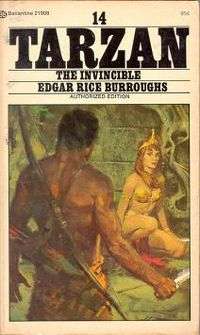La (Tarzan)
| La | |
|---|---|
|
Tarzan confronting La, from the cover of a paperback edition of Tarzan the Invincible by Edgar Rice Burroughs, Ballantine Books, 1974 | |
| First appearance | The Return of Tarzan |
| Created by | Edgar Rice Burroughs |
| Portrayed by | Mademoiselle Kithnou |
| Information | |
| Species | Human |
| Gender | Female |
| Occupation | Queen and High priestess, Witch |
| Nationality | African |
La is a character in Edgar Rice Burroughs's series of Tarzan novels. She first appeared in the second Tarzan novel, The Return of Tarzan (1913), and reappeared in the fifth, Tarzan and the Jewels of Opar (1916), the ninth, Tarzan and the Golden Lion (1923), and the fourteenth, Tarzan the Invincible (1930). She is also mentioned in the juvenile Tarzan story Tarzan and the Tarzan Twins, with Jad-Bal-Ja, the Golden Lion (1936), the events of which occur between Tarzan and the Golden Lion and Tarzan the Invincible.
La in the original Tarzan novels
La is the queen and high priestess of Opar, a lost city located deep in the jungles of Africa. Opar is portrayed as a surviving colony of ancient Atlantis in which incredible riches have been stockpiled down through the ages. The city's population exhibits extreme sexual dimorphism caused by a combination of excessive inbreeding, cross-breeding with apes, and selective culling of offspring. Consequently, female Oparians are physically perfect, while male Oparians are hideous bestial creatures.
On her first encounter with Tarzan, La falls in love with him, he being so much more physically perfect and attractive than the male Oparians. But Tarzan spurns her advances, as he is already committed to Jane Porter. This endangers his own life, as the religion of Opar condones human sacrifice, and La comes close to dedicating him to her city's "Flaming God" on a number of occasions. The two encounter each other time and again, as Tarzan keeps returning to Opar to replenish his personal wealth from its hoarded treasure.
La in other media
La first appeared on screen in The Adventures of Tarzan (1921), an early black and white silent Tarzan film based on The Return of Tarzan. She was portrayed by actress Lillian Worth, who played opposite Elmo Lincoln, the first screen Tarzan.
In the serial Tarzan the Tiger (1929), based on Tarzan and the Jewels of Opar, La was played by Mademoiselle Kithnou, and Tarzan by Frank Merrill.
La also appears in a few episodes of Tarzan: The Epic Adventures, played by Angela Harry.
La is also a recurring antagonist in Disney's The Legend of Tarzan animated series, voiced by veteran actress Diahann Carroll. Here, Opar is occupied by humanoid leopards created by La's magical staff to serve her (this is a very loose reference to the Leopard Men cult from Burroughs' novel Tarzan and the Leopard Men (1935), though in the books they have nothing to do with La). She tries to make Tarzan fall in love with her, and since he is already in love with Jane, has the Leopardmen stage Jane's death; Jane survives and Tarzan discovers the ruse.
The next time Tarzan meets La, her head Leopardman takes her staff, which possesses Jane. Working together, they save Jane. Learning that the Leopardmen want to be free, Tarzan shatters the staff, which turns the Leopardmen back to normal leopards and La to dust as Opar crumbles to nothing.
La's spirit survives, however, and subsequently possesses the bodies of others. Taking over Jane, she finds and reassembles the pieces of her staff, restoring Opar. She is also assisted by French businessman Renard Dumont, who she has transformed into a gibbon (which naturally lives in Southeast Asia, not Africa). When Tarzan and a Waziri native interfere, La takes over his body but is attacked by one of her animated statues, forced into the body of a rat, and captured in a bag.
Since the Disney version of Tarzan is child oriented, its La is not nude, but wears a bikini-like loincloth and a top exposing her arms and midriff, both made of panther fur and decorated with animal teeth, as well as jewelry. She is also the first boss of Disney's Disney's Tarzan: Return to the Jungle for the Game Boy Advance.
